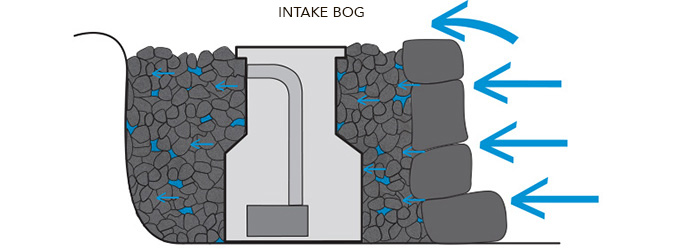Natural Filtration 301 Chapter 7
Downflow Bogs
“Downflow Bogs” are actually less bogs than gravel prefilters, because they are always on the intake side of the pump and they are rarely planted. There are three main varieties. First, the ‘grids under gravel’ style, at the bottom of the pond, covered with a relatively thin layer of gravel, typically less than a foot, which an external pump draws through. If the design sounds familiar to those of us who have kept fish tanks, it should – these are up-sized versions of common aquarium undergravel filters. Then there are huge, deep Intake Bogs, with feet of gravel through which water has to pass before finding its way into an intake, developed for large ponds and lakes to keep high flow pumps fed and sediments at bay. These intake filters are designed to trap and hold the prodigious amounts of gunk they accumulate until a massive cleanout is needed. Finally, there are Planted Downflow Bogs, a hybrid type that looks just like a shallow upflow bog in reverse. The intakes under them can vary, from screened bottom drains to slotted or perforated pipes to water matrix reservoir blocks, but they typically share the two common characteristics of a thin layer of gravel and plantings in that gravel.

All Downflow Bogs are subject to regular maintenance to keep from clogging. One of the main drawbacks to the Undergravel Filters and Intake Bogs is that the pond needs to be drained for servicing, unlike the Planted Downflow Bogs which are usually both shallow and located at the perimeter. But the physics of Downflow Bogs are also fundamentally different than Upflow Bogs. Where water is actively pumped through an Upflow Bog, with all the hydraulic pressure of a pump behind it, water is drawn through a Downflow Bog by nothing more than gravity.
The gist is it’s much easier to force water through a bed of planted gravel with the hydraulic pressure that pumps are designed to produce, than to gravity feed water through an intake bog, especially with friction in the plumbing lines. Sedimentation increases as velocity decreases, so that slower flow also means more goop tends to settle out in Downflow systems. Combine those factors with little holes or slots, small gravel and small diameter tubing and you have a maintenance issue absent in Upflow Bogs. Does that mean they don’t work? Absolutely not. Just like the undergravel filters in aquarium tanks they work very well until they need maintenance. Here’s the difference: if you need access to Downflow Grids, you have to disassemble the entire ecosystem, destroying the biology of the pond. This is not an option in most seasoned ponds with large fish or large numbers of fish because they need that biology to survive, period.
“Downflow Bogs” are actually less bogs than gravel prefilters, because they are always on the intake side of the pump and they are rarely planted. There are three main varieties. First, the ‘grids under gravel’ style, at the bottom of the pond, covered with a relatively thin layer of gravel, typically less than a foot, which an external pump draws through. If the design sounds familiar to those of us who have kept fish tanks, it should – these are up-sized versions of common aquarium undergravel filters. Then there are huge, deep Intake Bogs, with feet of gravel through which water has to pass before finding its way into an intake, developed for large ponds and lakes to keep high flow pumps fed and sediments at bay. These intake filters are designed to trap and hold the prodigious amounts of gunk they accumulate until a massive cleanout is needed. Finally, there are Planted Downflow Bogs, a hybrid type that looks just like a shallow upflow bog in reverse. The intakes under them can vary, from screened bottom drains to slotted or perforated pipes to water matrix reservoir blocks, but they typically share the two common characteristics of a thin layer of gravel and plantings in that gravel.

All Downflow Bogs are subject to regular maintenance to keep from clogging. One of the main drawbacks to the Undergravel Filters and Intake Bogs is that the pond needs to be drained for servicing, unlike the Planted Downflow Bogs which are usually both shallow and located at the perimeter. But the physics of Downflow Bogs are also fundamentally different than Upflow Bogs. Where water is actively pumped through an Upflow Bog, with all the hydraulic pressure of a pump behind it, water is drawn through a Downflow Bog by nothing more than gravity.
The gist is it’s much easier to force water through a bed of planted gravel with the hydraulic pressure that pumps are designed to produce, than to gravity feed water through an intake bog, especially with friction in the plumbing lines. Sedimentation increases as velocity decreases, so that slower flow also means more goop tends to settle out in Downflow systems. Combine those factors with little holes or slots, small gravel and small diameter tubing and you have a maintenance issue absent in Upflow Bogs. Does that mean they don’t work? Absolutely not. Just like the undergravel filters in aquarium tanks they work very well until they need maintenance. Here’s the difference: if you need access to Downflow Grids, you have to disassemble the entire ecosystem, destroying the biology of the pond. This is not an option in most seasoned ponds with large fish or large numbers of fish because they need that biology to survive, period.




